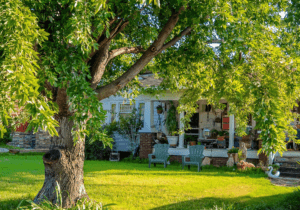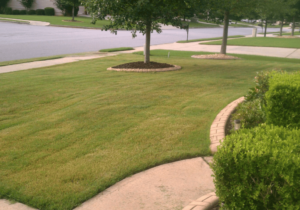Do you have a tree in your backyard that is not looking as healthy and vibrant as it used to be? If so, it’s important to get familiar with the signs of a dying tree and understand what can be done about it. Trees are an essential part of our environment and community. Keep reading for five common signs your tree is sick-and tips on how you can take action towards saving it!
Discolored or Missing Leaves
 If you have noticed discolored or missing leaves on your tree, then it is important to investigate the source of this issue. An effective place to start is to check the base of the tree for signs of decay – discoloration, missing bark, insect infestations and other changes should not be ignored. In some cases, a minor observation may indicate a serious problem that must be addressed quickly before it affects other portions of the plant. To gain an accurate understanding of what is going on with your tree, it might be wise to consult an expert if you are at all concerned about the condition.
If you have noticed discolored or missing leaves on your tree, then it is important to investigate the source of this issue. An effective place to start is to check the base of the tree for signs of decay – discoloration, missing bark, insect infestations and other changes should not be ignored. In some cases, a minor observation may indicate a serious problem that must be addressed quickly before it affects other portions of the plant. To gain an accurate understanding of what is going on with your tree, it might be wise to consult an expert if you are at all concerned about the condition.
Deformed Branches
While pruning your tree or shrub, be sure to look closely at each branch as you go. Particular attention should be paid to any that may be drooping, deformed, or cracked. These branches are often in need of help from a knowledgeable pruner. If left unchecked, deformed and weak branches can become the site of disease and insect infestations – something you don’t want for your trees! Pruning these weakened branches will not only allow for new growth but also make your trees healthier overall.
Branch Dieback
Branch dieback is a sign of trouble with a tree’s health. It typically commences with thinning of the foliage, or dead branches being noticeable. If the tree is exhibiting these symptoms, it’s important to not just trim away the dead branches and ignore the problem. Dieback is normally a result of something more systemic such as pest infestation, disease, or some other condition that requires attention. Identifying and diagnosing branch dieback quickly can help prevent further damage to the tree and allow for remediation measures that can keep trees beautiful and healthy for many years to come.
Fungal Growth
Fungal growth is a natural and common occurrence in the environment, particularly in wooded areas. It can be identified by its tell-tale signs; such as mushrooms, which generally form a ring around tree trunks or on the root system of certain plants. Depending on conditions and different levels of moisture, these mushrooms may range from small and unassuming to large and colourful. Moreover, while they are usually harmless, if left uncontrolled, fungal growth can spread quickly throughout a given area and cause detrimental damage to trees and plants. Thankfully, there are various ways to combat fungal growth for those who wish to protect their surroundings.
Poor Soil Drainage
Poor soil drainage can be a major issue when planting trees, as it interrupts the necessary absorption of water and nutrients. Without access to these resources, trees are unable to grow properly and are more susceptible to root rot which, if left untreated, will eventually cause the tree to die. It is therefore important to take measures that allow for proper drainage so that your tree has the optimal environment in which to thrive. This could involve carefully tending the quality of your soil or installing a drain system that allows excess water and air to escape. By giving consideration to your tree’s drainage needs, you can maximize its health and longevity.
Tree Care Tips
 Caring for the trees in your yard is essential to ensure they remain healthy and beautiful. Understanding what type of tree you have and how best to care for it is a great place to start. Regular inspections of your trees for disease or decay helps you catch signs of trouble early, and pruning dead branches can help keep them healthy as well as safer from storm damage. A layer of mulch around the tree base is great protection from extreme temperature fluctuations, water loss, pests, and weeds. Make sure to deeply water your tree regularly, particularly during dry spells. Supplementing with fertilizer helps nourish the soil around it and improves its growth rate and health as well. Keeping an eye on possible pests will not only protect your tree but can also avoid infestations elsewhere on your property too.
Caring for the trees in your yard is essential to ensure they remain healthy and beautiful. Understanding what type of tree you have and how best to care for it is a great place to start. Regular inspections of your trees for disease or decay helps you catch signs of trouble early, and pruning dead branches can help keep them healthy as well as safer from storm damage. A layer of mulch around the tree base is great protection from extreme temperature fluctuations, water loss, pests, and weeds. Make sure to deeply water your tree regularly, particularly during dry spells. Supplementing with fertilizer helps nourish the soil around it and improves its growth rate and health as well. Keeping an eye on possible pests will not only protect your tree but can also avoid infestations elsewhere on your property too.
Keeping a close eye on your trees is the best way to make sure they are healthy and safe. If you discover any of these symptoms of a potentially hazardous tree, there are many ways to save it. Understand what type of tree it is and give it the best care you can. Taking these steps will help ensure that your trees remain healthy for years to come.

